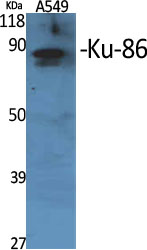PTRF (Phospho Tyr156) rabbit pAb
- Catalog No.:YP1774
- Applications:WB
- Reactivity:Human;Mouse;Rat
- Target:
- PTRF
- Gene Name:
- PTRF FKSG13
- Protein Name:
- PTRF (Phospho-Tyr156)
- Human Gene Id:
- 284119
- Human Swiss Prot No:
- Q6NZI2
- Mouse Gene Id:
- 19285
- Mouse Swiss Prot No:
- O54724
- Rat Swiss Prot No:
- P85125
- Immunogen:
- Synthesized peptide derived from human PTRF (Phospho-Tyr156)
- Specificity:
- This antibody detects endogenous levels of PTRF (Phospho-Tyr156) at Human, Mouse,Rat
- Formulation:
- Liquid in PBS containing 50% glycerol, 0.5% BSA and 0.02% sodium azide.
- Source:
- Polyclonal, Rabbit,IgG
- Dilution:
- WB 1:500-2000
- Purification:
- The antibody was affinity-purified from rabbit serum by affinity-chromatography using specific immunogen.
- Concentration:
- 1 mg/ml
- Storage Stability:
- -15°C to -25°C/1 year(Do not lower than -25°C)
- Other Name:
- Polymerase I and transcript release factor (Cavin-1)
- Observed Band(KD):
- 55kD
- Background:
- This gene encodes a protein that enables the dissociation of paused ternary polymerase I transcription complexes from the 3' end of pre-rRNA transcripts. This protein regulates rRNA transcription by promoting the dissociation of transcription complexes and the reinitiation of polymerase I on nascent rRNA transcripts. This protein also localizes to caveolae at the plasma membrane and is thought to play a critical role in the formation of caveolae and the stabilization of caveolins. This protein translocates from caveolae to the cytoplasm after insulin stimulation. Caveolae contain truncated forms of this protein and may be the site of phosphorylation-dependent proteolysis. This protein is also thought to modify lipid metabolism and insulin-regulated gene expression. Mutations in this gene result in a disorder characterized by generalized lipodystrophy and muscular dystrop
- Function:
- function:Termination of transcription by RNA polymerase I involves pausing of transcription by TTF1, and the dissociation of the transcription complex, releasing pre-rRNA and RNA polymerase I from the template. PTRF is required for dissociation of the ternary transcription complex.,PTM:Five truncated forms are found in the caveolae. These are thought to be the result of proteolysis and may be phosphorylation-dependent.,PTM:Phosphorylated. Present in active and inactive forms. Changes in phosphorylation pattern may alter activity.,similarity:Belongs to the PTRF/SDPR family.,subcellular location:Found at the surface of the caveolae. Also found in the plasma membrane, microsomal and cytosolic fractions and at a low level in the mitochondrial and nuclear fractions. Translocates to the cytoplasm from the caveolae upon insulin stimulation.,subunit:Interacts with RNA polymerase I and TTF1. Bind
- Subcellular Location:
- Membrane, caveola . Cell membrane . Microsome . Endoplasmic reticulum . Cytoplasm, cytosol . Mitochondrion . Nucleus . Translocates to the cytoplasm from the caveolae upon insulin stimulation (PubMed:17026959). Colocalizes with CAV1 in lipid rafts in adipocytes. Localizes in the caveolae in a caveolin-dependent manner (By similarity). .
- Expression:
- Adipocyte,Epithelium,Lung,Muscle,Pancreas,Testis,
- June 19-2018
- WESTERN IMMUNOBLOTTING PROTOCOL
- June 19-2018
- IMMUNOHISTOCHEMISTRY-PARAFFIN PROTOCOL
- June 19-2018
- IMMUNOFLUORESCENCE PROTOCOL
- September 08-2020
- FLOW-CYTOMEYRT-PROTOCOL
- May 20-2022
- Cell-Based ELISA│解您多样本WB检测之困扰
- July 13-2018
- CELL-BASED-ELISA-PROTOCOL-FOR-ACETYL-PROTEIN
- July 13-2018
- CELL-BASED-ELISA-PROTOCOL-FOR-PHOSPHO-PROTEIN
- July 13-2018
- Antibody-FAQs
- Products Images

- Western Blot analysis of various,using primary antibody at 1:1000 dilution. Secondary antibody(catalog#:RS23920) was diluted at 1:10000

